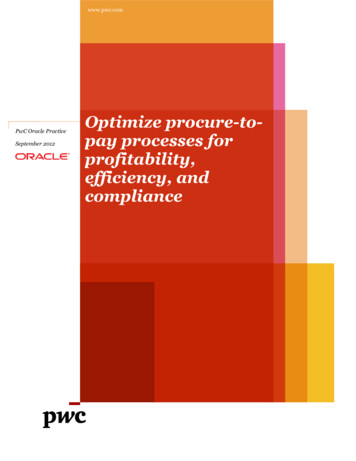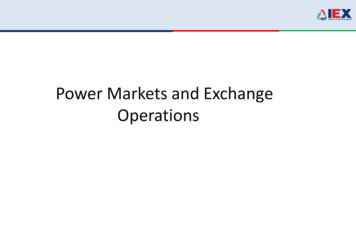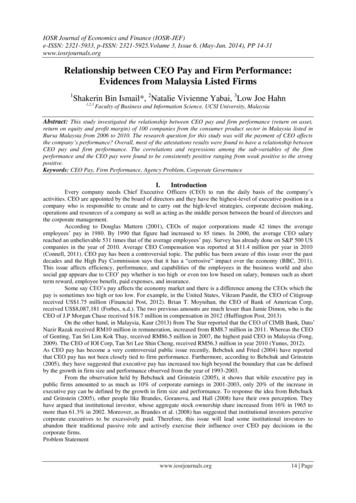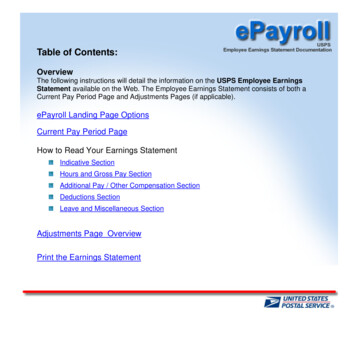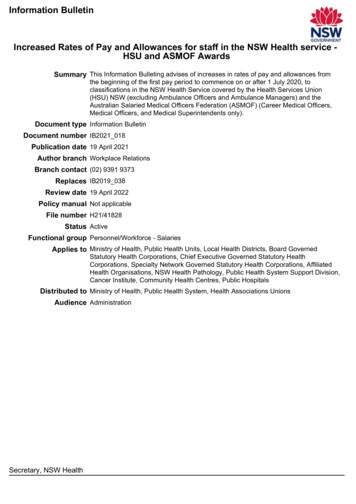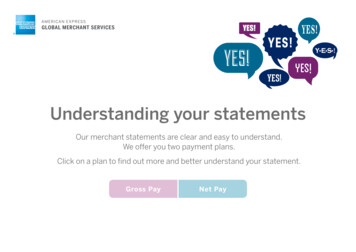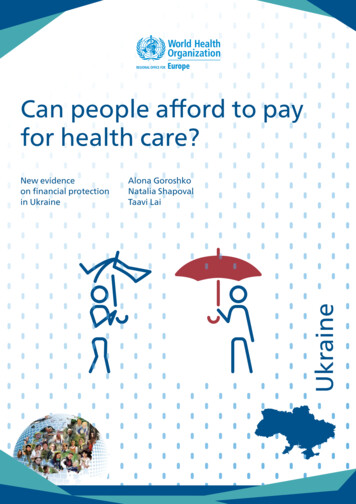
Transcription
Can people afford to payfor health care?Alona GoroshkoNatalia ShapovalTaavi LaiUkraineNew evidenceon financial protectionin Ukraine
WHO Barcelona Officefor Health Systems Strengthening2The WHO Barcelona Office is a centre of excellence in health financingfor universal health coverage (UHC). It works with Member States acrossWHO’s European Region to promote evidence-informed policy making.A key part of the work of the Office is to assess country and regionalprogress towards UHC by monitoring financial protection – the impactof out-of-pocket payments for health on living standards and poverty.Financial protection is a core dimension of health system performanceand an indicator for the Sustainable Development Goals.Established in 1999, the Office is supported by the Government of theAutonomous Community of Catalonia, Spain. It is part of the Division ofHealth Systems and Public Health of the WHO Regional Office for Europe. Foto: Robert Ramos/FPHSPThe Office supports countries to develop policy, monitor progressand design reforms through a combination of health system problemdiagnosis, analysis of country-specific policy options, high-level policydialogue and the sharing of international experience. It is also thehome for WHO training courses on health financing and health systemsstrengthening for better health outcomes.
Can people afford to payfor health care?New evidenceon financial protectionin UkraineWritten by:Alona GoroshkoNatalia ShapovalTaavi LaiEdited by:Erica RichardsonSarah ThomsonSeries editors:Sarah ThomsonJonathan CylusTamás Evetovits
iiAbstract & keywordsThis review is part of a series of country-based studies generating newevidence on financial protection in European health systems. Financialprotection is central to universal health coverage and a core dimension ofhealth system performance.HEALTHCARE FINANCINGHEALTH EXPENDITURESHEALTH SERVICES ACCESSIBILITYFINANCING, PERSONALPOVERTYUKRAINEUNIVERSAL COVERAGEISBN 9789289053655Address requests about publications of the WHO Regional Officefor Europe to:PublicationsWHO Regional Office for EuropeUN City, Marmorvej 51DK-2100 Copenhagen Ø, DenmarkAlternatively, complete an online request form for documentation, healthinformation, or for permission to quote or translate, on the Regional Officewebsite (http://www.euro.who.int/pubrequest). World Health Organization 2018All rights reserved. The Regional Office for Europe of the World Health Organization welcomesrequests for permission to reproduce or translate its publications, in part or in full. The designationsemployed and the presentation of the material in this publication do not imply the expression of anyopinion whatsoever on the part of the World Health Organization concerning the legal status of anycountry, territory, city or area or of its authorities, or concerning the delimitation of its frontiers orboundaries. Dotted lines on maps represent approximate border lines for which there may not yetbe full agreement. The mention of specific companies or of certain manufacturers’ products doesnot imply that they are endorsed or recommended by the World Health Organization in preferenceto others of a similar nature that are not mentioned. Errors and omissions excepted, the names ofproprietary products are distinguished by initial capital letters. All reasonable precautions have beentaken by the World Health Organization to verify the information contained in this publication.However, the published material is being distributed without warranty of any kind, either expressedor implied. The responsibility for the interpretation and use of the material lies with the reader. Inno event shall the World Health Organization be liable for damages arising from its use. The viewsexpressed by authors, editors, or expert groups do not necessarily represent the decisions or thestated policy of the World Health Organization.
iiiAbout the seriesThis series of country-based reviews monitors financial protection inEuropean health systems by assessing the impact of out-of-pocket paymentson household living standards. Financial protection is central to universalhealth coverage and a core dimension of health system performance.What is the policy issue? People experience financial hardship when outof-pocket payments – formal and informal payments made at the point ofusing any health care good or service – are large in relation to a household’sability to pay. Out-of-pocket payments may not be a problem if they aresmall or paid by people who can afford them, but even small out-of-pocketpayments can cause financial hardship for poor people and those whohave to pay for long-term treatment such as medicines for chronic illness.Where health systems fail to provide adequate financial protection, peoplemay not have enough money to pay for health care or to meet other basicneeds. As a result, lack of financial protection may reduce access to healthcare, undermine health status, deepen poverty and exacerbate health andsocioeconomic inequalities. Because all health systems involve a degree ofout-of-pocket payment, financial hardship can be a problem in any country.How do country reviews assess financial protection? Each review is basedon analysis of data from household budget surveys. Using householdconsumption as a proxy for living standards, it is possible to assess: how much households spend on health out of pocket in relation to theircapacity to pay; out-of-pocket payments that exceed a threshold of ahousehold’s capacity to pay are considered to be catastrophic; household ability to meet basic needs after paying out of pocket for health;out-of-pocket payments that push households below a poverty line or basicneeds line are considered to be impoverishing; how many households are affected, which households are most likely to beaffected and the types of health care that result in financial hardship; and changes in any of the above over time.Why is monitoring financial protection useful? The reviews identify thefactors that strengthen and undermine financial protection; highlightimplications for policy; and draw attention to areas that require furtheranalysis. The overall aim of the series is to provide policy-makers and otherswith robust, context-specific and actionable evidence that they can useto move towards universal health coverage. A limitation common to allanalysis of financial protection is that it measures financial hardship among
ivhouseholds who are using health services, and does not capture financialbarriers to access that result in unmet need for health care. For this reason,the reviews systematically draw on evidence of unmet need, where available,to complement analysis of financial protection.How are the reviews produced? Each review is produced by one or morecountry experts in collaboration with the WHO Barcelona Office for HealthSystems Strengthening, part of the Division of Health Systems and PublicHealth of the WHO Regional Office for Europe. To facilitate comparisonacross countries, the reviews follow a standard template, draw on similarsources of data (see Annex 1) and use the same methods (see Annex 2).Every review is subject to external peer review. Results are also shared withcountries through a consultation process held jointly by the WHO RegionalOffice for Europe and WHO headquarters. The country consultation includesregional and global financial protection indicators (see Annex 3).What is the basis for WHO’s work on financial protection in Europe? WHOsupport to Member States for monitoring financial protection in Europe isunderpinned by the Tallinn Charter: Health Systems for Health and Wealth,Health 2020 and resolution EUR/RC65/R5 on priorities for health systemsstrengthening in the WHO European Region 2015–2020, all of whichinclude a commitment to work towards a Europe free of impoverishingout-of-pocket payments for health. Resolution EUR/RC65/R5 calls onWHO to provide Member States with tools and support for monitoringfinancial protection and for policy analysis, development, implementationand evaluation. At the global level, support by WHO for the monitoring offinancial protection is underpinned by World Health Assembly resolutionWHA64.9 on sustainable health financing structures and universal coverage,which was adopted by Member States in May 2011. The SustainableDevelopment Goals (SDGs) adopted by the United Nations in 2015 alsocall for monitoring of, and reporting on, financial protection as one oftwo indicators for universal health coverage. Resolution EUR/RC67/R3 – aroadmap to implement the 2030 Agenda for Sustainable Development,building on Health 2020 – calls on WHO to support Member States in movingtowards universal health coverage.Comments and suggestions for improving the series are most welcome andcan be sent to euhsf@who.int.
vContentsFigures, tables & boxesAbbreviationsAcknowledgementsExecutive ytical approachData sources3453.3.13.23.3Coverage and access to health careCoverageAccess, use and unmet needSummary7812154.4.14.24.34.4Household spending on healthOut-of-pocket paymentsInformal paymentsWhat drives changes in out-of-pocket ncial protectionHow many households experience financial hardship?Who experiences financial hardship?Which health services are responsible for financial hardship?How much financial hardship?International comparisonSummary313233353738396.6.16.26.3Factors that strengthen and undermine financial protectionFactors affecting people’s capacity to pay for health careHealth system factorsSummary414244487. Implications for policy49ReferencesAnnex 1. Household budget surveys in EuropeAnnex 2. Methods used to measure financial protection in EuropeAnnex 3. Regional and global financial protection indicatorsAnnex 4. Glossary of terms5255586467
viFiguresFig. 1. Self-reported unmet need forhealth services by type of care andincome quintile14Fig. 10. Annual out-of-pocketspending on medicines and inpatientcare per person by consumptionquintile, in real terms25Fig. 19. Out-of-pocket payments asa share of total household spendingamong households with catastrophicspending by consumption quintile37Fig. 2. Self-reported unmet need forinpatient care due to cost by income,201615Fig. 11. Health spending per personby financing agent, in real terms27Fig. 3. Share of households with andwithout out-of-pocket payments18Fig. 12. Out-of-pocket payments as ashare of total spending on health28Fig. 20. Out-of-pocket payments asa share of total household spendingamong further impoverishedhouseholds37Fig. 4. Share of households with andwithout out-of-pocket payments byconsumption quintile19Fig. 13. Share of households at risk ofimpoverishment after out-of-pocketpayments32Fig. 5. Annual out-of-pocketspending on health care per personby consumption quintile20Fig. 14. Share of households withcatastrophic out-of-pocket payments33Fig. 6. Out-of-pocket payments forhealth care as a share of householdconsumption by consumption quintile21Fig. 7. Breakdown of total out-ofpocket spending by type of health care22Fig. 8. Breakdown of total out-ofpocket spending by type of healthcare and consumption quintile23Fig. 9. Annual out-of-pocketspending on health care per personby type of health care24Fig. 15. Breakdown of householdswith catastrophic spending by risk ofimpoverishment34Fig. 21. Incidence of catastrophicspending on health and out-ofpocket share of total spendingon health in selected Europeancountries, latest year available38Fig. 22. Changes in the cost of meetingbasic needs, capacity to pay and theshare of households living below thebasic needs line, in real terms42Fig. 23. Trends in poverty43Fig. 16. Share of householdswith catastrophic spending byconsumption quintile34Fig. 24. Public spending on healthand GDP per person, WHO EuropeanRegion, 201544Fig. 17. Breakdown of catastrophicspending by type of health care35Fig. 25. Public spending on health as ashare of total Government spending45Fig. 18. Breakdown of catastrophicspending by type of health care andconsumption quintile36Fig. 26. Acute care hospitaldischarges per 100 people47
viiTablesBoxesTable 1. Key dimensions ofcatastrophic and impoverishingspending on health4Box 1. Unmet need for health care13Table 2. User charges for publiclyfinanced health services, 201810Table 3. Gaps in publicly financedand VHI coverage11
VHIEuropean Health Interview SurveyEuropean UnionEuropean Union Member States as of 1 July 2013European Union Statistics on Income and Living Conditionsgross domestic productKyiv International Institute of SociologySchool of Public Health, National University of Kyiv-Mohyla AcademyUkrainian hryvniavoluntary health insurance
ixAcknowledgementsThis series of financial protection reviews is produced by the WHO BarcelonaOffice for Health Systems Strengthening, which is part of the Division ofHealth Systems and Public Health, directed by Hans Kluge, in the WHORegional Office for Europe. The series editors are Sarah Thomson, JonathanCylus and Tamás Evetovits.The review of financial protection in Ukraine was written by Alona Goroshko(WHO Country Office, Ukraine), Natalia Shapoval (Consultant, Kyiv Schoolof Economics) and Taavi Lai (WHO Country Office, Ukraine). It was edited byErica Richardson (WHO Barcelona Office).The WHO Barcelona Office is grateful to Nataliia Riabtseva (Ministry of Healthof Ukraine), Tetiana Stepurko (National University of Kyiv-Mohyla Academy)and Guillaume Dedet and Melitta Jakab (WHO Regional Office for Europe) fortheir feedback on an earlier draft of the review.Thanks are also extended to Ihor Verner, Natalia Vlasenko, Inna Osypova andLarysa Rokytko (State Statistics Service of Ukraine) for their contribution tothe study.Data on financial protection were shared with the Ministry of Healthof Ukraine as part of a WHO consultation on universal health coverageindicators held in 2018.WHO gratefully acknowledges funding from the United KingdomDepartment for International Development, under the Making CountryHealth Systems Stronger programme, and from the Government of theAutonomous Community of Catalonia, Spain.The production of this review was coordinated by Ruth Oberhauser (WHOBarcelona Office). Additional support came from José Cerezo Cerezo (figures),Alex Mathieson (copyediting), Aleix Artigal and Alex Prieto (design andtypesetting) and Juan García Domínguez (checking proofs).Please cite the review as: Goroshko A, Shapoval N, Lai T (2018). Can peopleafford to pay for health care? New evidence on financial protection inUkraine. Copenhagen: WHO Regional Office for Europe.
xExecutive summaryUkraine is currently implementing profound reforms to the health systemwith the aim of moving towards universal health coverage and enhancingefficiency and equity in public spending on health.This review provides evidence on the extent to which households in Ukraineexperienced financial hardship when using health services in the pre-reformperiod of 2010-2015. It provides a baseline for monitoring the impact of thereforms and future trends.The health system has come to rely increasingly heavily on out-of-pocketpayments, partly in response to a fall in public spending on health, whichwas in turn linked to recent conflict and political instability and to dramaticeconomic decline in 2014 and 2015.Household budget survey data show that the share of households reportingout-of-pocket payments grew from 86% in 2010 and 90% in 2013 to 93%in 2015. The level of out-of-pocket payments per person fell slightly in realterms between 2010 and 2015 overall, but increased for the poorest quintile.Financial hardship has also increased over time. Between 2010 and 2015,the incidence of impoverishing out-of-pocket payments rose from 7.6%of households to 9.0%, while the incidence of catastrophic out-of-pocketpayments rose from 11.5% to 14.5%.Catastrophic spending on health is heavily concentrated in the poorestquintile. The overall increase in the incidence of catastrophic spendingbetween 2010 and 2015 was largely driven by a significant increase inincidence for the poorest quintile.Medicines and inpatient care are the largest drivers of catastrophic spendingoverall. For the poorest households, catastrophic spending is mainly caused bymedicines; for the richest households, it is mainly caused by inpatient care.Financial hardship reflects major de facto gaps in health coverage, meaningpeople must pay out of pocket for a high share of outpatient and inpatientservices and almost all medicines, even though all citizens are entitled topublicly financed health services that are supposed to be free at the point ofuse. These gaps are not covered by voluntary health insurance.Gaps in coverage can be attributed to very low levels of public spending onhealth, inefficiency and inequity in allocating and spending public resources,and widespread informal payments, particularly for inpatient care.
xiUnmet need for health care is a growing problem. Survey data indicate thatthe share of people reporting unmet need doubled between 2010 and 2015.Income inequality in unmet need is significant. If unmet need had not grownso rapidly during the study period, the incidence of catastrophic spending onhealth might have been even higher in 2015.Improving financial protection will only be possible through increasingpublic investment in health and tackling inefficiencies in the health system,accompanied by reform of coverage policy.Medicines illustrate the need for comprehensive action combining increasedinvestment, better coverage design, efforts to enhance efficiency and greatertransparency and accountability. Public spending on medicines is extremelylow; current coverage design exposes people to the cost of many medicines,which is particularly challenging for households when living standards arefalling and prices are rising; there is almost no regulation of medicine prices;and policies to ensure appropriate prescribing and dispensing are limited.The recently introduced Affordable Medicines Programme is a welcome steptowards improving access to medicines and financial protection for peoplewith chronic conditions. This approach should be extended, with increasedpublic investment, to include more international non-proprietary namesbased on agreed criteria and to enable the introduction of exemptions forvulnerable groups of people. Inappropriate prescribing and dispensing alsoincrease out-of-pocket payments and require policy attention, accompaniedby strategies to change the culture of medicine use.
Can people afford to pay for health care in Ukraine?1. Introduction1
Can people afford to pay for health care in Ukraine?This review assesses the extent to which people in Ukraine experience financialhardship when they use health services, including medicines. Research showsthat financial hardship is more likely to occur when public spending on healthis low relative to gross domestic product (GDP), and out-of-pocket paymentsaccount for a relatively high share of total spending on health (Xu et al., 2003;Xu et al., 2007; WHO, 2010). Increases in public spending or reductions inout-of-pocket payments are not in themselves guarantees of better financialprotection, however. Policy choices are also important.Over time, public spending on health as a share of GDP has been consistentlylow in Ukraine, with some fluctuation; in 2014 it fell from a peak of 3.8%to 2.9% and remained at this low level in 2015, well below the average forcountries in the WHO European Region (5%) and European Union (EU)(6%) and slightly below the average for lower middle-income countries(3.1%) (WHO, 2018). Out-of-pocket payments have grown as a share of totalspending on health, reaching 48% in 2015, which is among the highest inthe European Region, although it remains below the average for lowermiddle-income countries (55%). National data suggest that the out-of-pocketshare was even higher in 2016. The decline in public spending on health andsubsequent increase in out-of-pocket payments are linked to recent conflictand political instability and to dramatic economic decline in 2014 and 2015.Despite these major challenges, Ukraine is implementing profound reformsto the health system, as set out in the Law on State Financial Guarantees ofHealth Care Services to the Population approved by parliament in 2017 witheffect from 2018. The reforms aim to move Ukraine towards universal healthcoverage and enhance efficiency and equity in public spending through thecreation of a single, national pool, better and more transparent resourceallocation and strategic purchasing, including a purchaser–provider split,more explicitly defined health benefits and new methods of paying healthcare providers.This review provides evidence on the extent to which households in Ukrainefaced financial hardship when using health services during the pre-reformperiod of 2010 to 2015. It provides a baseline for monitoring the impact ofthe reforms and future trends. Several global studies of financial protectionhave included Ukraine (Xu et al., 2003, 2007; Bredenkamp et al., 2012;Saksena et al., 2014a, 2014b; WHO & World Bank, 2015; Bernabé et al., 2017)and a handful have focused exclusively on Ukraine (Murphy et al., 2013;Masood et al., 2015), but all draw on data ranging from the mid-1990s to themid-2000s (Yerramilli et al., 2018). This analysis is the first to use nationallyrepresentative data up to 2015.The review is structured as follows. Section 2 sets out the analytical approachand sources of data used to measure financial protection. Section 3 providesa brief overview of health coverage and access to health care. Sections 4 and5 present the results of the statistical analysis, with a focus on out-of-pocketpayments in Section 4 and financial protection in Section 5. Section 6 providesa discussion of results of the financial protection analysis and identifiesfactors that strengthen and undermine financial protection: those thataffect people’s capacity to pay for health care and health system factors.Section 7 highlights implications for policy. Annex 1 provides information onhousehold budget surveys; Annex 2 the methods used; Annex 3 regional andglobal financial protection indicators; and Annex 4 a glossary of terms.2
Can people afford to pay for health care in Ukraine?2. Methods3
Can people afford to pay for health care in Ukraine?4This section summarizes the study’s analytical approach and main data sources.More detailed information can be found in Annexes 1–3.2.1 Analytical approachThe analysis of financial protection in this study is based on an approachdeveloped by the WHO Regional Office for Europe, building on establishedmethods of measuring financial protection (Wagstaff & van Doorslaer, 2003;Xu et al., 2003). Financial protection is measured using two main indicators:catastrophic out-of-pocket payments and impoverishing out-of-pocketpayments. Table 1 summarizes the key dimensions of each indicator.Table 1. Key dimensions of catastrophic and impoverishing spending on healthNote: See Annex 4 for definitions of words initalics.Source: Thomson et al. (2018).Catastrophic out-of-pocket paymentsDefinitionThe share of households with out-of-pocket payments that are greater than40% of household capacity to pay for health careNumeratorOut-of-pocket paymentsDenominatorTotal household consumption minus a standard amount to cover basicneeds. The standard amount to cover basic needs is calculated as theaverage amount spent on food, housing and utilities by householdsbetween the 25th and 35th percentiles of the household consumptiondistribution, adjusted for household size and compositionDisaggregationResults are disaggregated into household quintiles by consumption.Disaggregation by place of residence (urban–rural), age of the head of thehousehold, household composition and other factors is included whererelevantImpoverishing out-of-pocket paymentsDefinitionThe share of households impoverished or further impoverished after out-ofpocket paymentsPoverty lineA basic needs line, calculated as the average amount spent on food,housing and utilities by households between the 25th and 35th percentilesof the household consumption distribution, adjusted for household sizeand compositionPovertydimensionscapturedThe share of households further impoverished, impoverished, at risk ofimpoverishment and not at risk of impoverishment after out-of-pocketpaymentsDisaggregationResults can be disaggregated into household quintiles by consumption andother factors where relevant
Can people afford to pay for health care in Ukraine?2.2 Data sourcesThe study analyses anonymized microdata from the household budgetsurveys conducted by the State Statistics Service of Ukraine in 2010, 2013and 2015. The data sample consisted of 10 428 households in 2010 (with aresponse rate of 81%), 10 528 in 2013 (response rate 83%) and 9097 in 2015(response rate 77%) (State Statistics Service of Ukraine, 2018).Some aspects of the household budget survey data and the context inwhich they were collected should be noted. First, the Ukraine survey countshousehold spending on health spas, dentures and medicines covered by theGovernment under social protection programmes as household spending onhealth, even though they are paid for by the Government. As these servicesonly account for a small share of public spending on health, however (3.1% in2010 and 2.4% in 2015), their inclusion under household spending on healthdoes not have a significant effect on the study’s results.Second, the category “medicines” includes medicines used in bothoutpatient and inpatient settings, which is not the norm in other Europeancountries, where the “medicines” category usually includes outpatientmedicines only. As a result, it is not possible to distinguish betweenhousehold spending on medicines used for treatment in different settingsin Ukraine. The implication is that household spending on inpatient caremay be underestimated because it does not count household spending onmedicines used in inpatient settings.Last, inflation rose rapidly during the study period due to the dramaticeconomic decline Ukraine experienced in 2014 and 2015. All currency unitsin the study are presented in nominal Ukrainian hryvnia (UAH), with noteson inflation-adjusted spending where relevant. In 2016, 1000 UAH had theequivalent purchasing power of 108 in the average EU country.5
Can people afford to pay for health care in Ukraine?3. Coverage and accessto health care7
Can people afford to pay for health care in Ukraine?This section briefly describes the governance and dimensions of publiclyfinanced health coverage (population entitlement, service coverage and usercharges) in Ukraine and reviews the role played by voluntary health insurance(VHI). It summarizes some key trends in rates of health service use, levels ofunmet need for health care, and inequalities in service use and unmet need.3.1 CoverageHealth coverage is governed by Article 49 of the Constitution of Ukraine,subsequently elaborated in a special decision of the Constitutional Courtin May 2002. This entitles all citizens to health services in Government- andcommunity-owned facilities without user charges (co-payments) and withoutlimits on the volume of care provided.Ukraine has found it difficult to introduce mechanisms that would allow itto: define publicly financed health benefits to reflect the reality of very lowlevels of public spending on health; and enable benefits to target those mostin need of publicly financed access. Previous efforts have been rejected in thecourts. As a result, access to many health services is rationed implicitly on thebasis of whether people are able to pay for them out of pocket.The Government of Ukraine initiated health system reforms, includingmajor reforms to health financing policy, in 2016. Legislation to enablehealth benefits to be defined based on explicit criteria such as health need,financial protection, equity and efficiency came into force in 2017. Subsidiaryregulation to specify the process will be approved in 2018, so the institutionalframework for a more transparent and equitable process for defining healthbenefits is now being determined. The reforms are likely to result in changesto the scope of health services covered, with effect from 2020. This studyfocuses on the pre-reform period.3.1.1 Population entitlementArticle 49 of the Constitution grants everyone access to health services inpublic facilities without co-payment. Entitlement to receive services in aspecific facility is linked to residence; formally, a person can receive servicesonly in facilities in the local area (rayon or municipality) in which they areofficially registered. If people are willing to pay informally, however, it ispossible to be treated in other facilities.3.1.2 Service coverageThe publicly financed benefits package is not defined. There are some explicitexclusions – for example, cosmetic surgery, infertility treatment and dentalprostheses – but in practice, access to many health services is determinedimplicitly, either on the basis of availability in public facilities or on whetherpeople can afford to pay for them out of pocket.Outpatient services are provided by primary care centres, policlinics and dentists.There is a formal system of referral to specialist care, with legislation allowingdirect access to dentists, gynaecologists, paediatricians and other specialists8
Can people afford to pay for health care in Ukraine?when a person has a chronic condition. Despite this formal requirement,people willing to seek care directly from specialists are able to do so, includingby paying physicians informally. Dental care is subject to official co-paymentswhere the local council permits public facilities to charge patients; this varies bymunici
without out-of-pocket payments 18 Fig. 4. Share of households with and without out-of-pocket payments by consumption quintile 19 Fig. 5. Annual out-of-pocket spending on health care per person by consumption quintile 20 Fig. 6. Out-of-pocket payments for health care as a share of household consumption by consumption quintile 21 Fig. 7.

